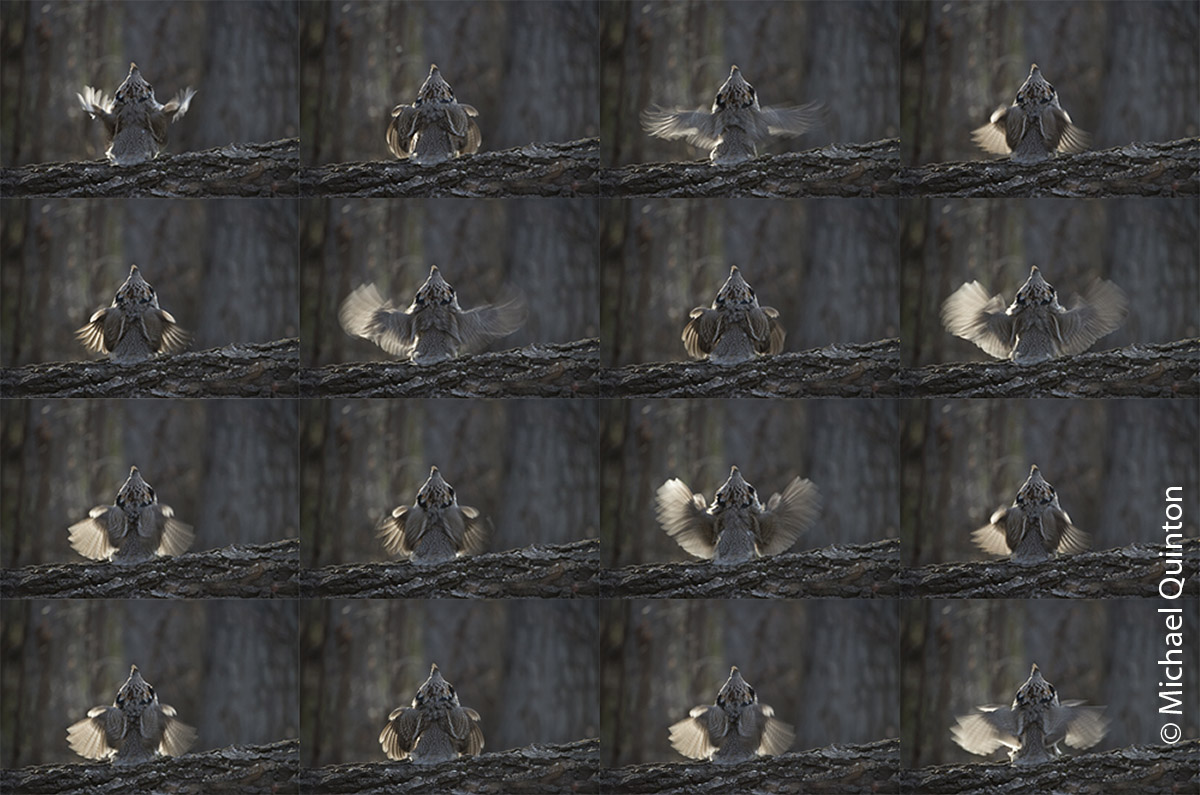 A ruffed grouse male moves slowly through thick cover as it feeds on buds, last years berries and new leaves.
A ruffed grouse male moves slowly through thick cover as it feeds on buds, last years berries and new leaves.
Interior Alaska is definitely spruce grouse country. But along creeks and river bottoms, in old burns, in fact almost anywhere where several species of trees grow in thickets, narrow veins of ruffed grouse habitat can be found. Along the Slana River not far from where it enters the still modest Copper River, aspen, poplar, birch, white and black spruce, alder and a jumble of willow species form thickets where the cryptic ruffed grouse lives. Rose and high bush cranberry in the understory provide year round food for the few grouse that survive there.
 Slana River bottoms and glacier crowned Mount Sanford.
Slana River bottoms and glacier crowned Mount Sanford.
Each spring, April in these northern parts, brings a new and exciting rhythm to these bottom lands. A dull thud, like the distant slamming of a car door, quickly escalates into a rapid drum roll that can be heard for several hundred yards. If one moves slowly and quietly, nearly impossible in the dry covering of poplar and aspen leaves, it may be possible to actually catch the grouse in the act. It is the male ruffed grouse who does the drumming. Forest wildlife often use sound to communicate their location to potential mates. The male grouse often picks large prominent fallen trees for its broadcasting. He usually has several favorite logs.
 Solitary male ruffed grouse advertises for a mate from atop a favored log.
Solitary male ruffed grouse advertises for a mate from atop a favored log.
 Composite photograph of a drumming ruffed grouse.
Composite photograph of a drumming ruffed grouse.
 Photography of shy ruffed grouse can be a challenge. This male eventually became used to me.
Photography of shy ruffed grouse can be a challenge. This male eventually became used to me.
Ruffed grouse, depending on their level of hunting pressure and individual nature, can be lumped into categories ranging from dumb tame to extremely shy. Photography of the latter can be almost impossible without a photographic blind.
Even when you can locate a tolerant drummer, they often pick a log surrounded by impenetrably dense cover. If so open up a shooting lane or two, (unlawful in National Parks, a bad idea in National Refuges or where habitat and grouse are uncommon, and not a good idea anywhere where human impact might be harmful.) This is acceptable only where human impact is minimal.
 Camera shutter speed 1/125 of a second will leave wings blurred.
Camera shutter speed 1/125 of a second will leave wings blurred.
 Even 1/6000 of a second shutter speed didn’t completely freeze this drummers wings.
Even 1/6000 of a second shutter speed didn’t completely freeze this drummers wings.
 A combination of slow shutter speed (1/125 of a second) and backlight is my favorite technique.
A combination of slow shutter speed (1/125 of a second) and backlight is my favorite technique.
 The sight of a female ruffed grouse will cause an instantaneous reaction from a drummer to full courtship display. The feather display is accompanied by a repetitious plucking of vegetation. Here the displaying male holds a clipping of green vegetation.
The sight of a female ruffed grouse will cause an instantaneous reaction from a drummer to full courtship display. The feather display is accompanied by a repetitious plucking of vegetation. Here the displaying male holds a clipping of green vegetation.
 Male ruffed grouse back to his camouflaged foraging outfit.
Male ruffed grouse back to his camouflaged foraging outfit.
